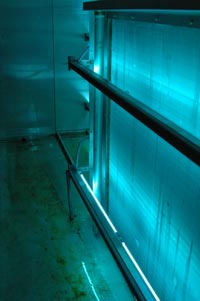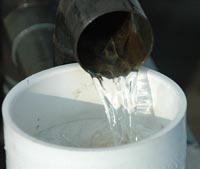Case Study: Delaware Biotechnology Institute
Indoor air treatment comes with fringe benefits
 Poor indoor air quality is harmful to building occupants, but in a biotech lab, it can also compromise sensitive research and laboratory experiments.
Poor indoor air quality is harmful to building occupants, but in a biotech lab, it can also compromise sensitive research and laboratory experiments.
The Delaware Biotechnology Institute at the University of Delaware decided to equip the air handling units in its six-year-old, 72,000-square-foot facility with high output “UVC Emitters™” made by Steril-Aire, Inc. of Burbank, Calif. While optimizing the air quality with germicidal UVC, the institute discovered an unexpected fringe benefit: The condensate from the coils is now so clean that it can be used as make-up water in the cooling tower, achieving substantial savings in water usage.
UVC is a type of ultraviolet energy in the 260-nanometer frequency. The "C" wavelength is the most germicidal in the UVC spectrum.
“HVAC systems are an acknowledged breeding ground for mold and microbial growth,” said Robert Pekala, institute engineering and operations manager. “The biofilm that builds up on coils can contaminate not only the air that circulates through the building but also the condensate water that is created as the system cools and dehumidifies. If you were to take that water from an air handler untreated with UVC and add it to the cooling tower, you would have to increase the use of biocides and chemicals substantially to counteract the added microbial contamination in the cooling tower.”
Pekala explained that condensate coming off air handling units that have UVC is essentially distilled 55-degrees-Fahrenheit water that can be pumped into the cooling tower.
 During cooling season, he noted, the units produce as much as 5,000 gallons a day of condensate. Added to the cooling tower, this water can replace roughly half of the 7,000 to 10,000 gallons a day that evaporate from the cooling tower during hot weather conditions.
During cooling season, he noted, the units produce as much as 5,000 gallons a day of condensate. Added to the cooling tower, this water can replace roughly half of the 7,000 to 10,000 gallons a day that evaporate from the cooling tower during hot weather conditions.
Since starting the program in 2005, the institute has experienced a direct savings between $4,000 and $6,000 during the yearly cooling season. “It is important to point out that we have been able to accomplish these savings with no increase in the level of biocides used in the cooling tower,” Pekala adds. “This can be attributed solely to the germicidal effects of the UVC devices. Also, there are definite energy savings achieved by mixing the 55-degree Fahrenheit make-up water with the much warmer (80 to 90 degrees Fahrenheit) water in the tower, though we have not quantified this.”
Pekala believed that Steril-Aire’s germicidal UVC devices used with high-efficiency air filters would provide the protection the institute needed. A life cycle cost and energy-saving analysis projected a six-month payback on the initial UVC investment, followed by an $18,000 savings in the remainder of the first year, and $36,000 annual savings in subsequent years.
The savings come from reductions in energy needed to run the air handling units. By keeping coils clean and free of organic buildup, UVC reduces pressure drop across the coils and increases net cooling capacity.
 Prior to startup in 2005, Rebekah Helton, Ph.D., a microbiologist and researcher at the institute, sampled the biofilm and condensate in the air handling units. Within a few weeks after installation, all visual biofilm was gone from both units. Since then, the coils have remained pristine and samples taken one year later detected no biofilm. Viral abundance within unit condensate was below detectable limits, and no bacteria were detected.
Prior to startup in 2005, Rebekah Helton, Ph.D., a microbiologist and researcher at the institute, sampled the biofilm and condensate in the air handling units. Within a few weeks after installation, all visual biofilm was gone from both units. Since then, the coils have remained pristine and samples taken one year later detected no biofilm. Viral abundance within unit condensate was below detectable limits, and no bacteria were detected.
The UVC devices require no special maintenance except for annual changeout of the bulbs or lamps by an in-house HVAC technician.